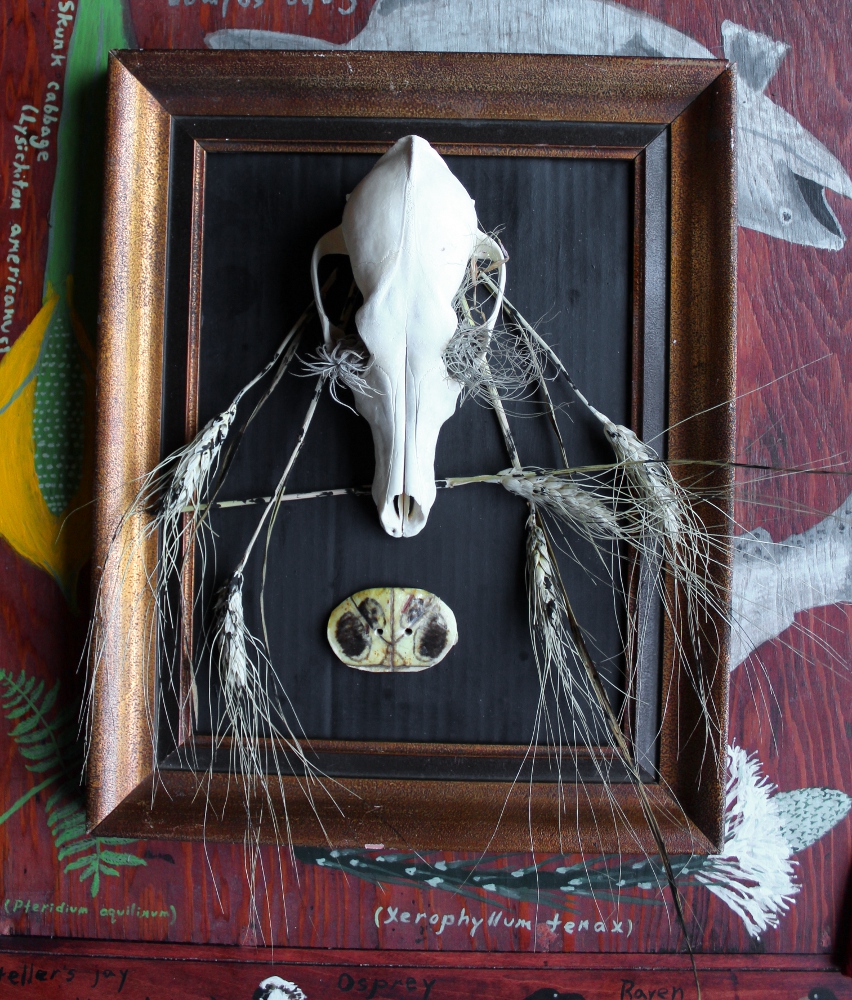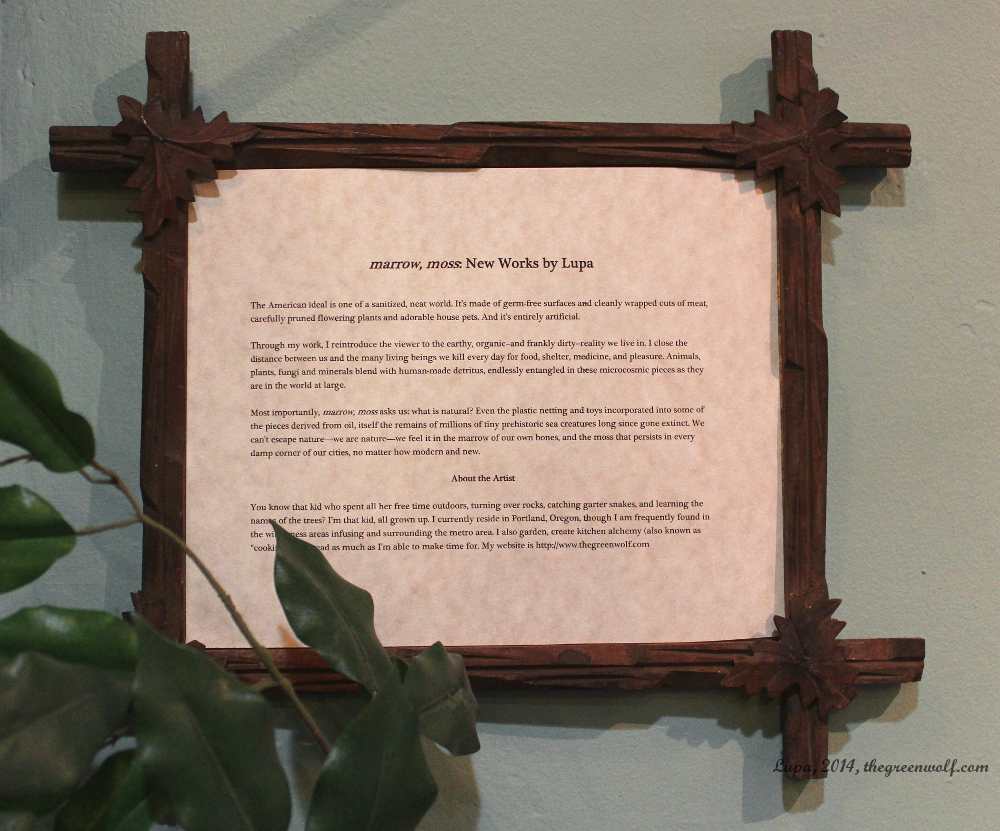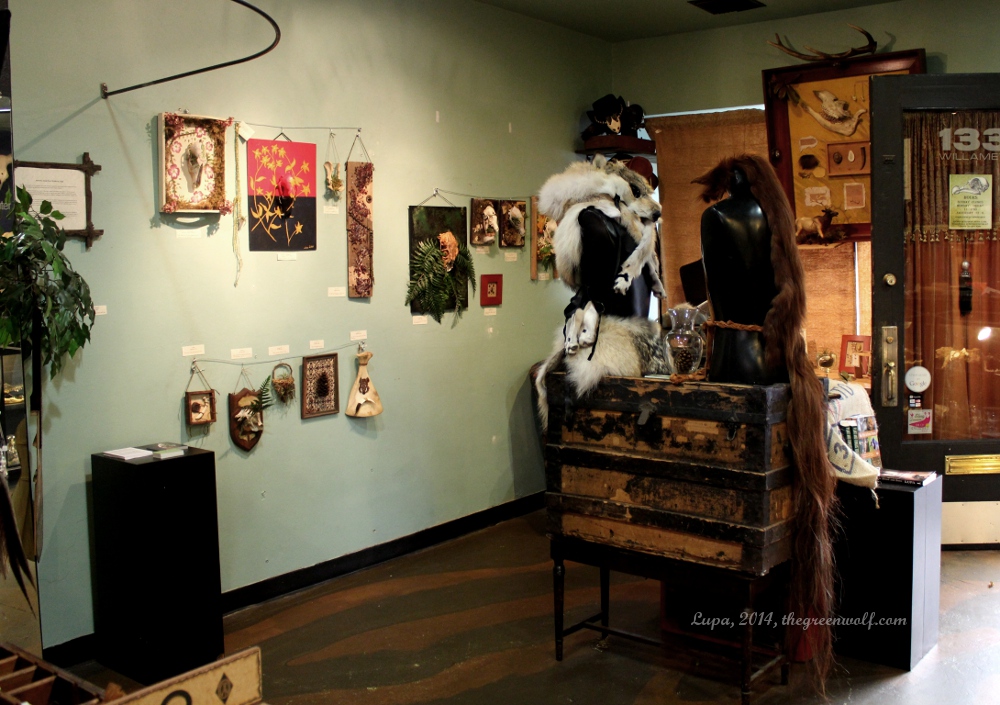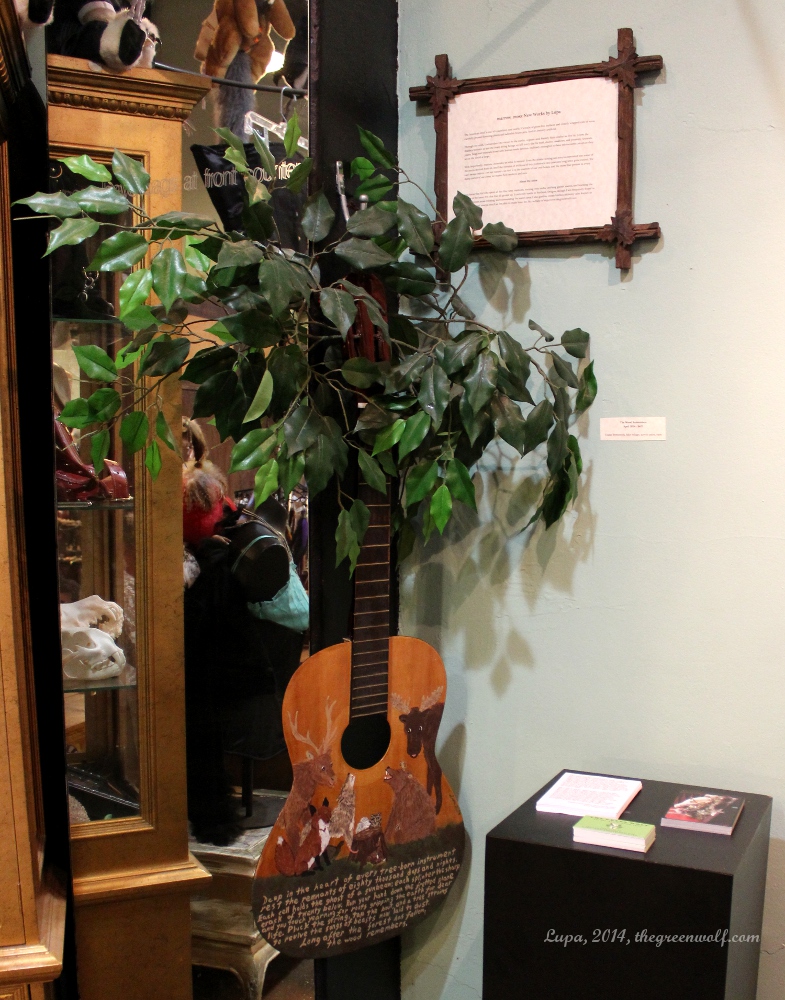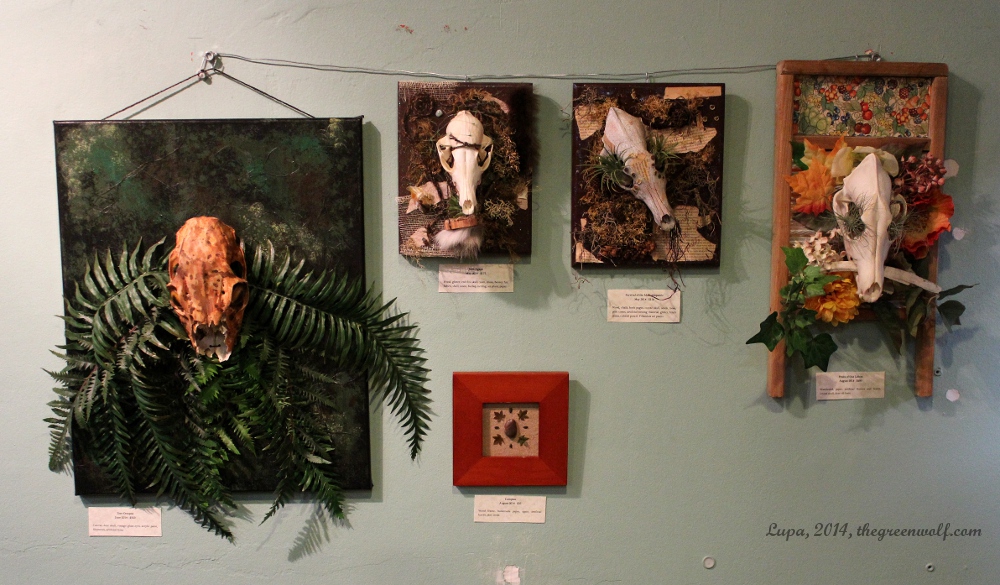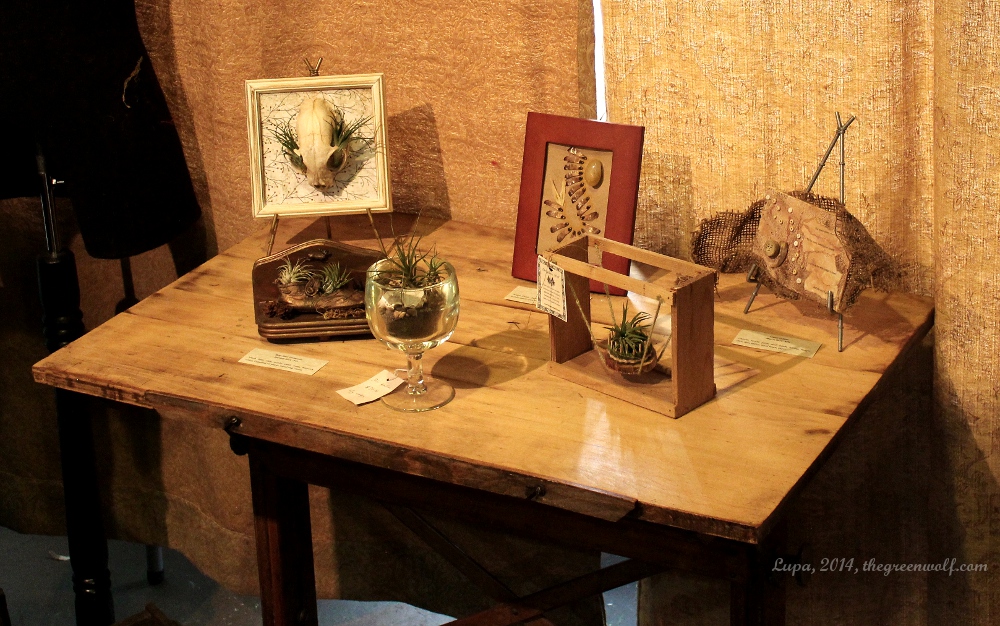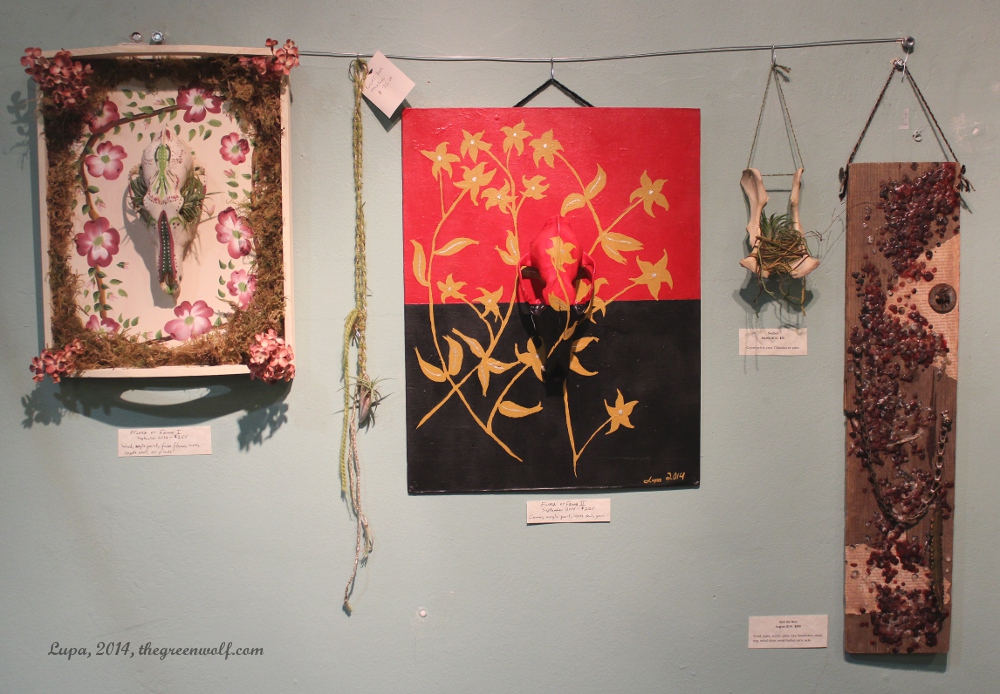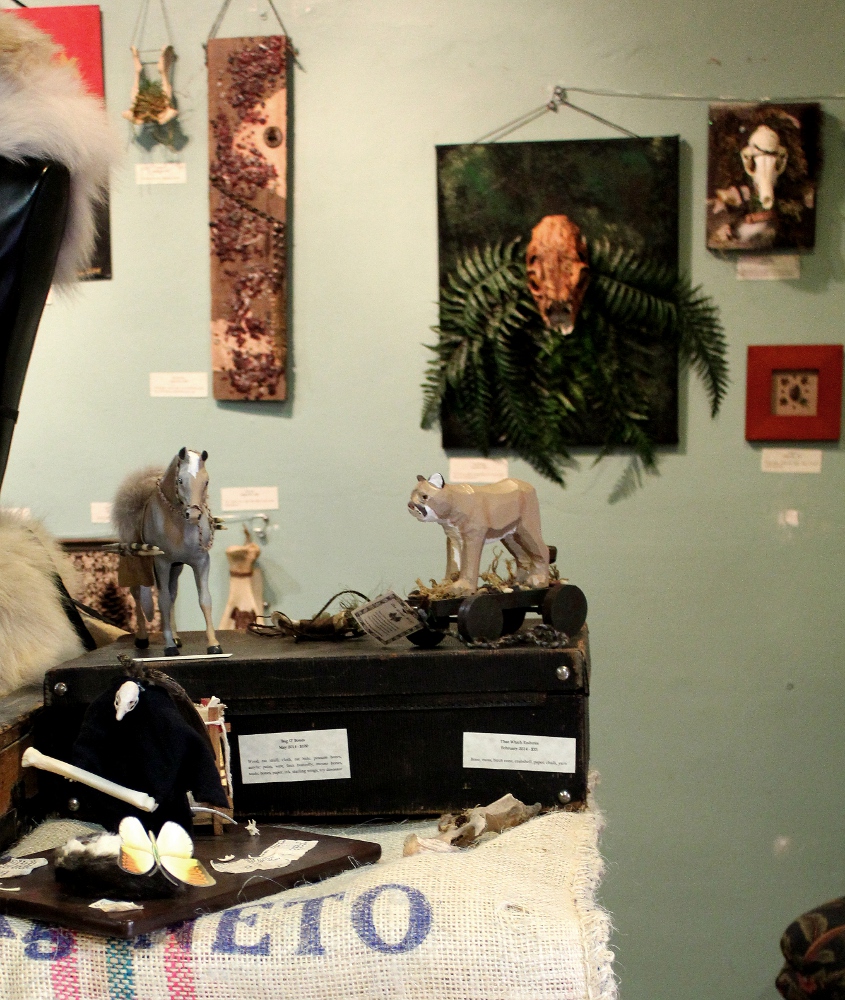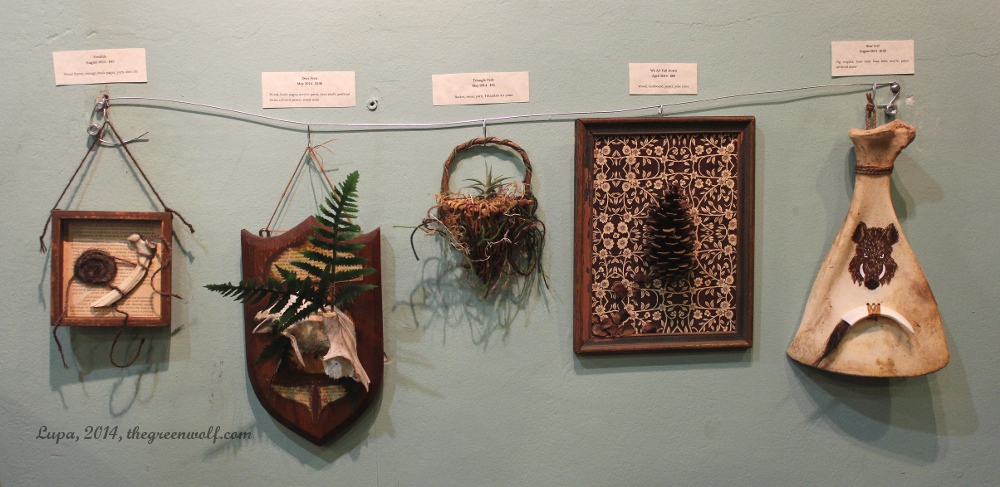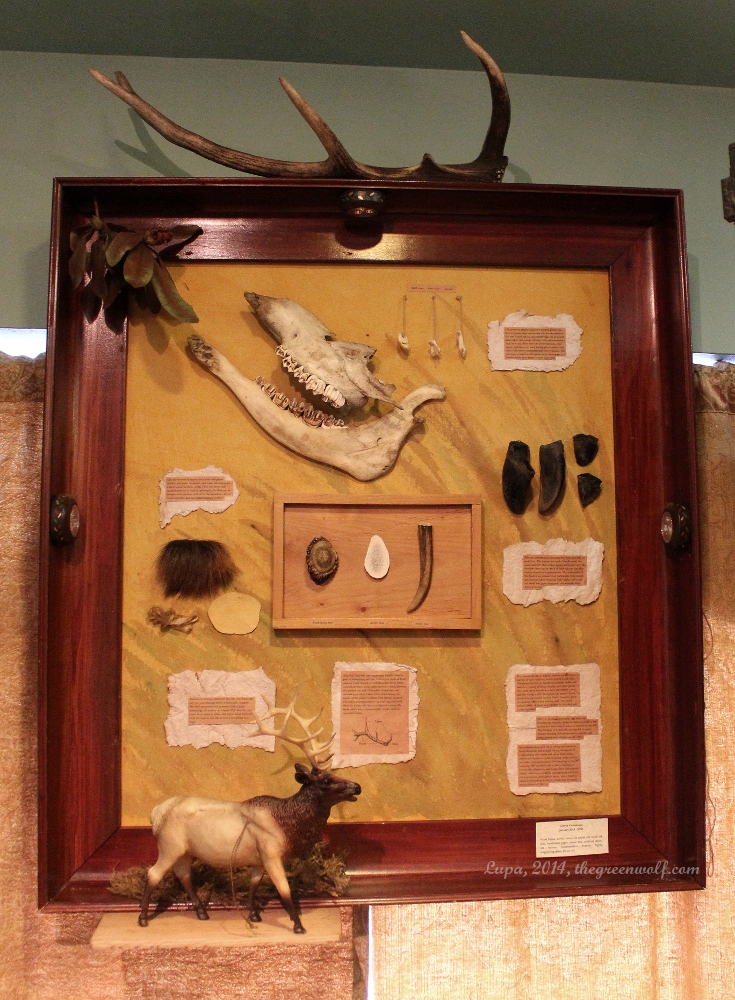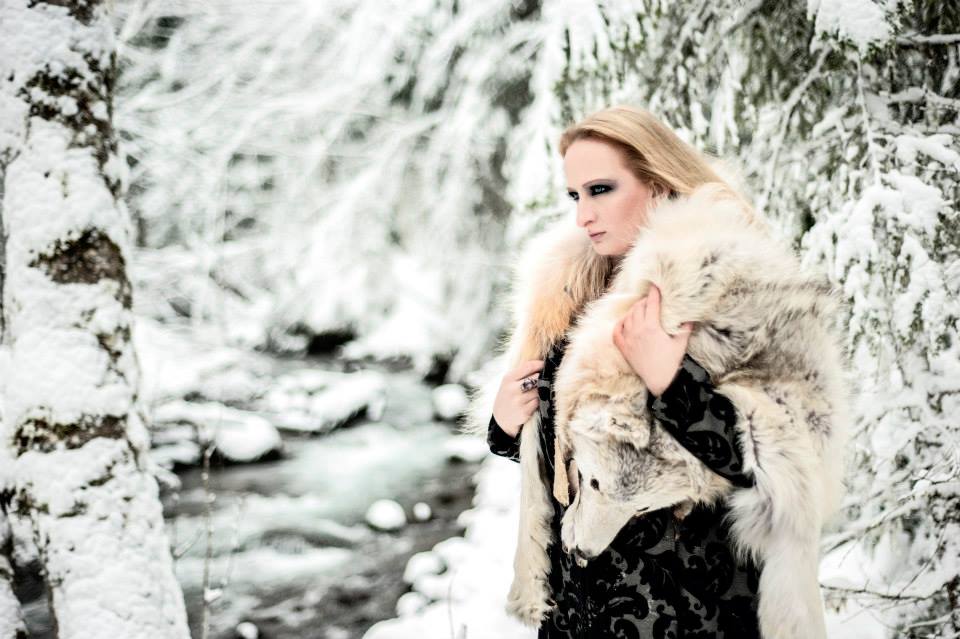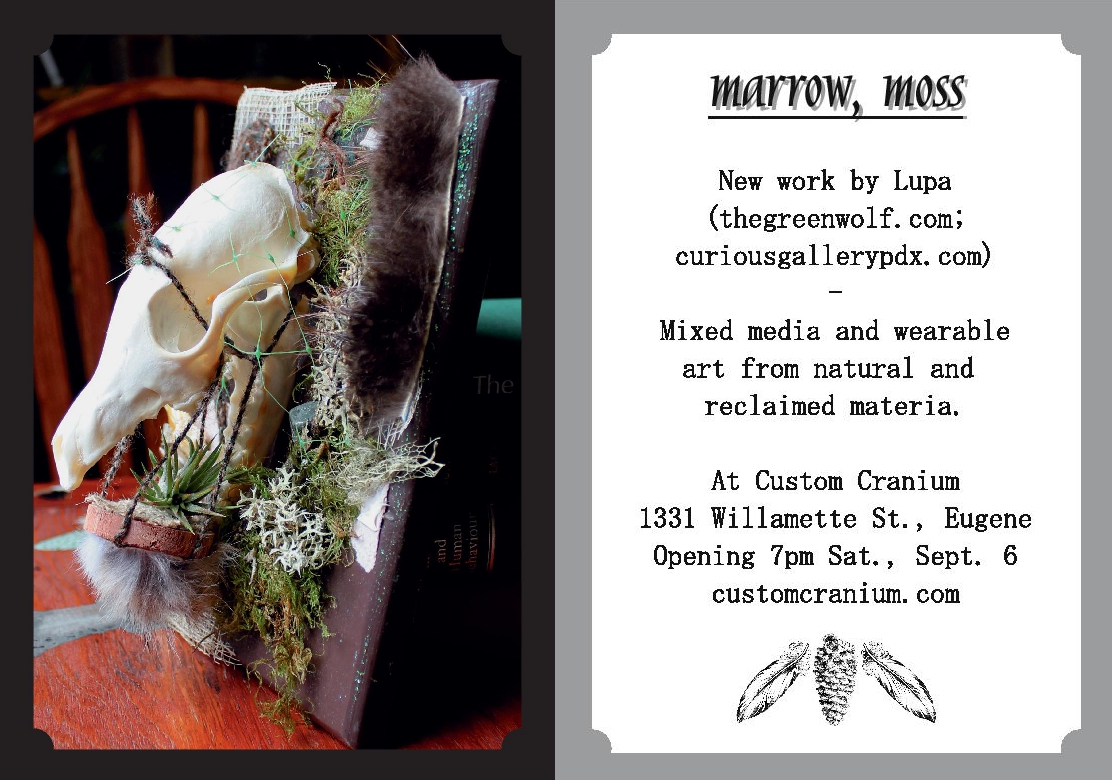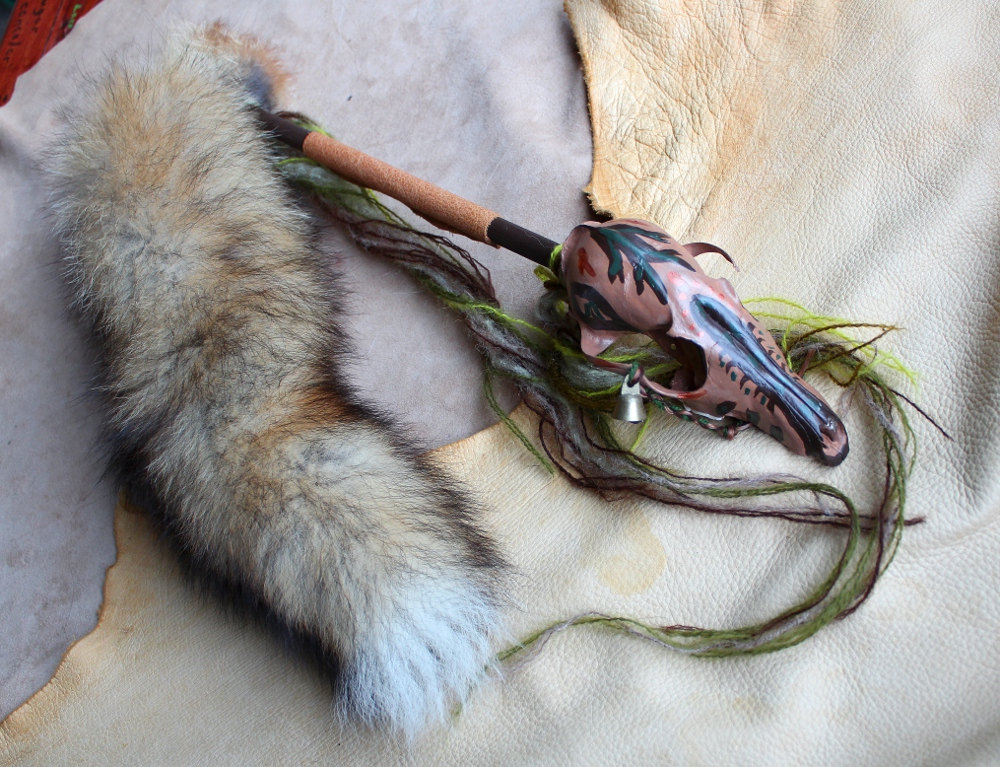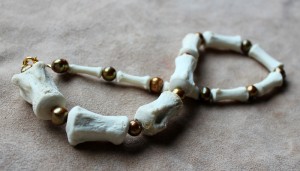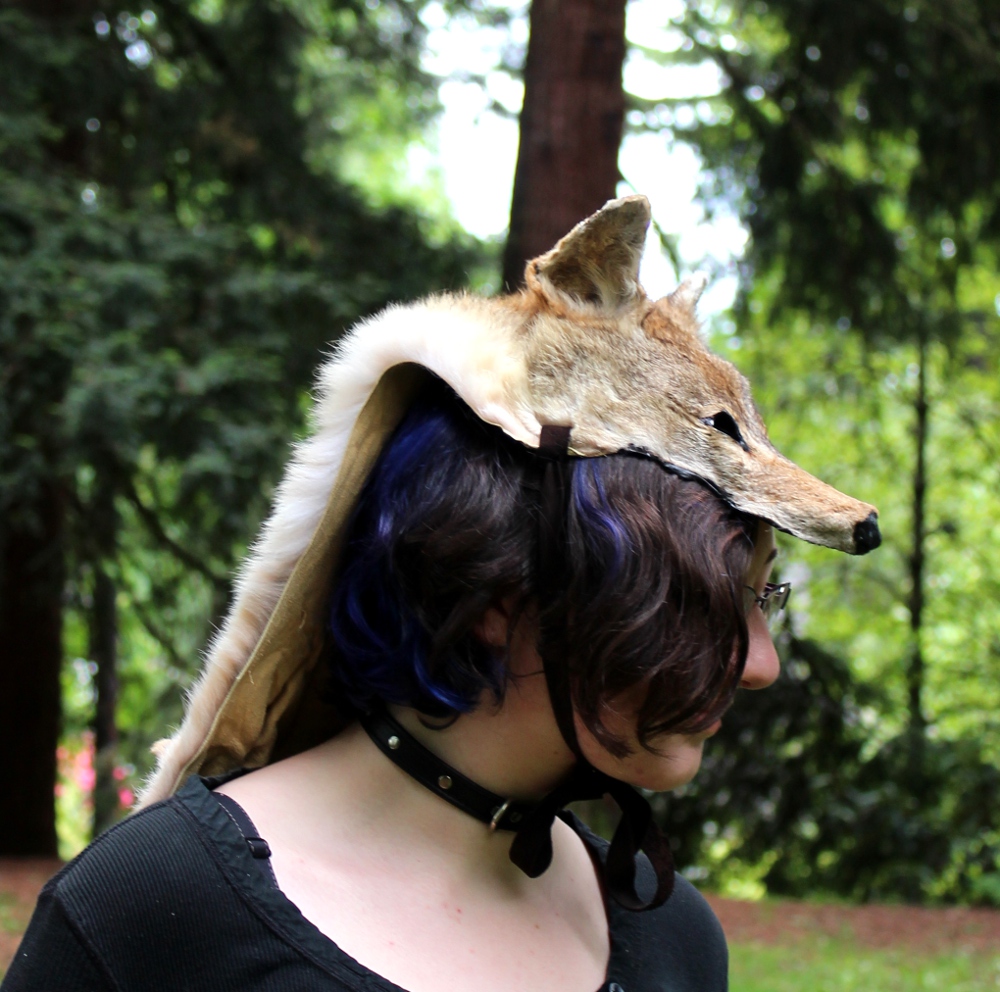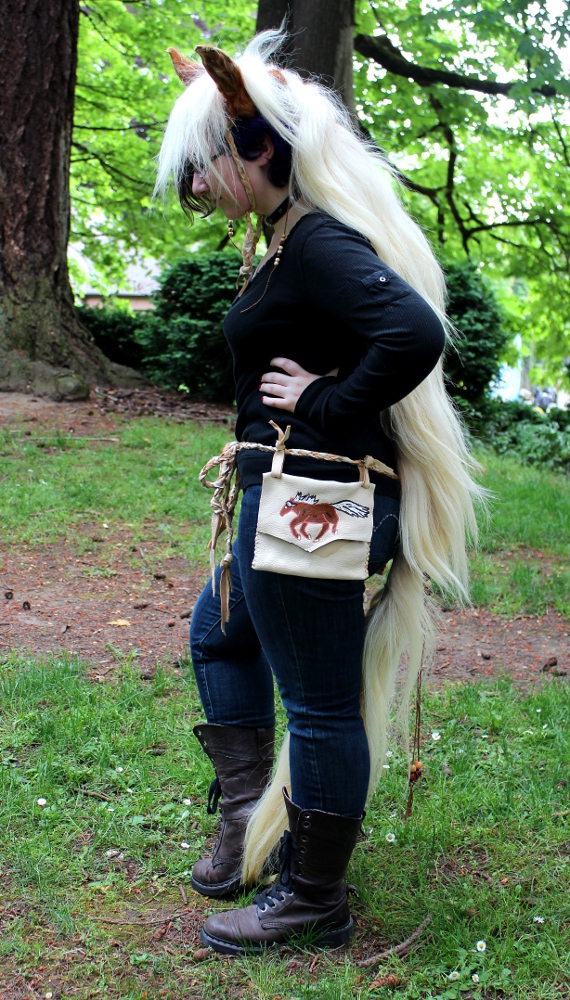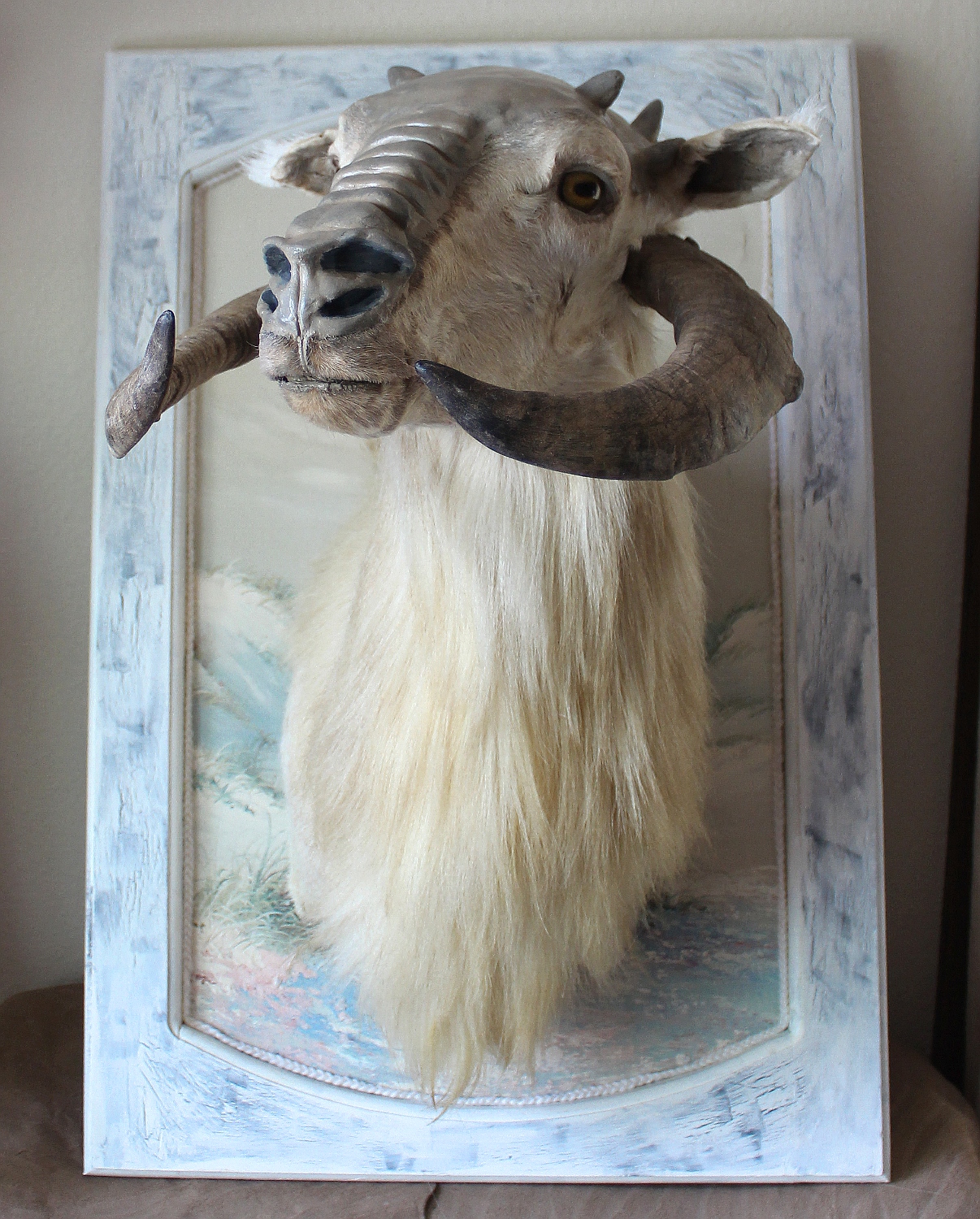I am happy to announce that my newest assemblage piece, “Blight (Five of Coins)”, will be on display in the Tarot show at Splendorporium at 3421 SE 21st Avenue in Portland, OR! The opening will be Friday, October 3 from 7pm – 9pm, and the show will be up through October 31 for your Halloween art-seeing (and purchasing) pleasure! More information at http://www.splendorporium.net/
Category Archives: Artwork
Pictures from marrow, moss
As promised, here are some photos from marrow, moss, my solo show currently on exhibit at Custom Cranium at 1331 Willamette Street in Eugene, OR. They’re not the best photos as the lighting wasn’t as bright as it could have been and I’m an amateur photographer at best, but consider it an invitation to check the works out in person for a much better effect! If you didn’t get to join us at the opening on September 6, you can still go see the show through mid-October.
Announcing Costume and Prop Rental Services
You may have noticed a new page in the menu at the top of the Green Wolf site. Costume and Prop Rental does what it says on the tin–it outlines basic information for photographers, filmmakers and other creatives who need hides, bones, or costuming and other works made from them, but who don’t need to buy the items outright.
For several years I’ve been quietly renting out costume pieces and other art and props for photographers, film makers, and other fellow creatives who need something tailored for a single event/shoot, and I finally put together an official page for this service on my site. If you are a creative sort in need of props or costuming for a project, or if you know folks in relevant fields who may be interested, all curious parties may head to https://thegreenwolf.com/costume-and-prop-rental/ for more information.
Please feel free to pass this on, and thank you!
(Featured image by Adam Michaud of New World Industries, copyright Lady Raven Productions)
Quick Patreon Update: New Goodies, New Goal
Hey, folks! I’m going AFK for a few days later this week for a much-postponed backpacking trip, but before I leave I wanted to give you a quick update on my Patreon account! It’s been live for a little over a month, and I already have almost $300 in monthly patronage—thank you to everyone who’s become a patron, spread the word, and otherwise been supportive!
I’ve since added more patron rewards, including one for a monthly totem card reading, and more cabinet of curiosities options. I’ve gotten great feedback from my patrons so far about the goodies I’ve been sending them. And if we can get my monthly patronage up to $500, I will send every single one of my patrons a nifty natural history specimen, anywhere in the world.
Want to help me reach that goal? Head over to http://www.patreon.com/lupagreenwolf to become my patron today 🙂
Announcing My New Solo Art Show: marrow, moss
I am pleased to announce my upcoming solo art show! marrow, moss will feature new assemblage and costume pieces, including works never before displayed online or off. Since 1998 I have been creating art from hides, bones, stones and other natural materials; part funerary art to honor the beings that once wore these remains, and part microcosmic encapsulation of nonhuman nature, my work is an alchemical transformation of abandoned and trivialized materials into creations toward a better world. As with all of my work, a portion of the proceeds from sales of the pieces in this show will be donated to a nonprofit organization that benefits natural places and their inhabitants.
I invite my readers to attend the opening of this show; admission is free, and in addition to my works you may explore the diverse and glorious stock of one of the Pacific Northwest’s premier natural history shops.
Where: Custom Cranium, 1331 Willamette St., Eugene, OR
When: Saturday, September 6, 7pm
My deepest thanks to Darien at Custom Cranium for inviting me to show at her shop.
Purification Ritual For Hides, Bones and Other Animal Remains
My artwork and other practices with hides, bones and other animal remains have always been intensely spiritual. I didn’t like seeing them displayed as mere trophies or status symbols, and so set out to remake them as sacred creations and beloved personal artifacts, guides in costumed shapeshifting and curiosities for consideration. I wanted them to be revered, not merely possessed.
There are a lot of factors outside of my control in this. I can’t control who buys a particular item (other than turning away the occasional rude customer) or what they do with something I made once they have it. I’ve just had to learn to let go and let gods in that regard. But I can do my best to seek out my target audience and present my work in a way that will appeal to them, and keep working my intent into everything I create. And I add a bit of a ritual to it, too, whether you want to believe it changes things on a distinctly spiritual level, or simply helps me stay focused on my task.
I realized recently that while I reference the ritual I do quite a bit, I haven’t actually written about it much. So I figured now would be as good a time as any to share it with you in detail. You’re welcome to try it out for yourself, modify it as needed, but please do give credit when sharing.
There are three parts of the ritual: the meditation, the purification, and the offering.
The meditation is the part that takes the longest. I’ll sit with each piece that I’ve created, and meditate with the spirits of the animals whose remains are incorporated into the art. I have a conversation with them, and ask each of them to show me what they’d like me to know about their lives and deaths. Sometimes I get a vivid, play-by-play of their last moments; other times I get highlights of their lives, especially when they were young (even other animals like to reminisce about childhood). I’ve often gotten some of this information already; as I create the art I’m having an ongoing conversation with them about what I’m creating and what they’d like me to include, and it’s a good opportunity to chat with them about other things as well.
The purification involves a physical smudging of the completed artwork. I used to use sagebrush, but these days I tend more toward cedar or sweetgrass as I like the aroma better. I generally only use a tiny bit at one time; rather than burning an entire sage smudge stick, I’d just pull out one lone leaf and light it. Part of this is to keep from aggravating my asthma, but it’s also so I’m using fewer resources. One leaf purifies as well as thirty in my experience, even if it takes just a touch longer to smudge the entire piece. It’s really an issue of quality over quantity. Other forms of purification can work, too, though I recommend against water-based ones since water can hurt certain hides and other remains. I also say a prayer over each piece at this time, asking that they will go to someone who will love them and cherish them for who and what they are, and thanking them for letting me work with them in the first place.
The offering is the part that’s changed the most over the years. When I first got started, I would offer small drilled stones and shells to the totems of the animals whose remains I used. When I had enough to fill a small leather pouch dedicated to that totem, I would make the stones into a necklace, and then give it to someone who worked with that totem. Over time I became less enamored of this. What was I going to offer to the totems of the stones I made as offerings to the animals? After all, they’re a part of nature, too, not just objects to be given and taken. So I instead diverted the money I would have spent on the stones and shells toward donations to nonprofit groups, and increased my volunteer time to compensate as well.
No purification ritual goes exactly the same way as another. Sometimes the meditation is brief, other times it’s looooong. Occasionally I get a spirit making a special request for an offering or other gesture. That’s why I don’t have this all written out in one big “First say this, then do this” format. It’s more a set of guidelines than holy writ. The point is to remind myself that I am working with skin spirits and sacred remains, and that what I do is meant to honor.
Note: If you enjoyed this post, please consider bringing home a copy of my book Skin Spirits: The Spiritual and Magical Uses of Animal Parts, which details my years of spiritual work with hides, bones and other animal remains, along with step by step instructions on how to make assorted ritual tools with them.
A Very Special Announcement For My Readers, Fans, and the Like
I have been making my art since 1998. My first article was published in Sagewoman in 2004. 2006 saw the publication of my first book and the creation of my first serious blog. Over the years I’ve explored many different avenues for getting my work out there, from writing for countless publications in pixels and paper, to expanding my vending setup to make it easier to meet you all in person, to stepping just a teensy bit into the gallery scene, among other ventures both successful and ill-conceived.
All along the way I’ve had the support of so many people. You’ve cheered me on, given me constructive feedback, shared your own experiences and questions with me, and introduced others to my art and writing. And, certainly not of the least importance, you’ve supported my work financially, buying my art and books, attending paid workshops, purchasing totem readings, and otherwise compensating me for my time and effort and creations. In short, you’ve given me a part of yourselves so that I can continue to have a roof over my head (and more art supplies under that roof!) All of that tells me that you like my work and want to keep seeing me create things.
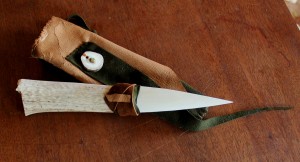 Your support has helped me become more productive; I’ve been completely self-employed since 2011, which, of course, means that I get to art and write full-time. (More than full-time, really–eighty hour weeks are not uncommon here.) One of the challenges of this otherwise awesome situation is that there’s no steady paycheck. I could have a week where I pull in a four figure sum, and then the next week I make just enough to get some quarters for the laundry. While it’s a challenge I’m up to, I want to make this a more sustainable venture.
Your support has helped me become more productive; I’ve been completely self-employed since 2011, which, of course, means that I get to art and write full-time. (More than full-time, really–eighty hour weeks are not uncommon here.) One of the challenges of this otherwise awesome situation is that there’s no steady paycheck. I could have a week where I pull in a four figure sum, and then the next week I make just enough to get some quarters for the laundry. While it’s a challenge I’m up to, I want to make this a more sustainable venture.
Which is why I’d like to introduce you to my Patreon profile. Patreon is a platform that allows artists to share content (including exclusive works) with modern-day artistic patrons who make a monthly financial contribution to the artist’s efforts. You don’t have to give a whole lot, either. For just one dollar a month, you get access to patron-only content–sneak peeks of blog posts days before they go public, work in progress pictures of art, and other things that patrons alone will be the first–or only–to see. And there are other monthly perks depending on level of patronage, including but not limited to:
–Monthly profiles of animal, plant, fungus and other totems, viewable only to my patrons and not to be posted to this blog
–A “book of the month club” where I’ll send you one of my currently available books every month until you have the entire set
–Several art subscription opportunities, where each month I send you something I made, from jewelry to ritual tools to elaborate costumes
–Three different cabinet of curiosities subscriptions, where each month I send you a selection of curiosities I’ve made or curated, and at the end of six months you have a complete collection, including a booklet that I’ve written to explain the theme of the collection and what makes each piece in it awesome
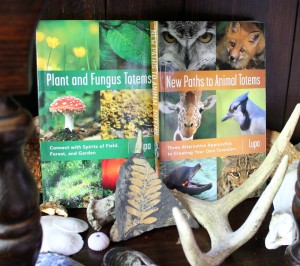 Plus there are even MORE perks for you if the total amount given by all my current patrons reaches certain milestones. The first time it hits $100 per month, every patron gets a hand-drawn thank you card from me. On the other hand, if I somehow accumulate enough patrons giving enough money that I’m making $2,500 per month, I’m going to write you a full-length book. (No, seriously. I will write a book, minimum 45,000 words, on some topic of nature spirituality, and self-publish it in both ebook and paperback format, and my patrons will get a free copy, and no one else will have access to it for at least a year. I would LOVE to write you a book, just sayin’.)
Plus there are even MORE perks for you if the total amount given by all my current patrons reaches certain milestones. The first time it hits $100 per month, every patron gets a hand-drawn thank you card from me. On the other hand, if I somehow accumulate enough patrons giving enough money that I’m making $2,500 per month, I’m going to write you a full-length book. (No, seriously. I will write a book, minimum 45,000 words, on some topic of nature spirituality, and self-publish it in both ebook and paperback format, and my patrons will get a free copy, and no one else will have access to it for at least a year. I would LOVE to write you a book, just sayin’.)
What do I get out of this? Not just money. I get stability and more of an ability to budget from month to month. And that’s a huge benefit. Knowing that I am guaranteed to get a certain amount of money coming in from my patrons, regardless of whatever other sales and income I get, helps reduce the stress of chasing after dollars.
Moreover, it tells me that those who choose to become my patrons really want to see me keep making creative things. I love making art and writing for myself, don’t get me wrong, but it takes other people loving my art and writing enough to compensate me for it that allows me to keep creating at the rate that I do. And at the end of the day, it feels really, really good that enough people like what I do to enable me to be a full-time creative sort. It’s a great motivator to keep making cool things happen.
So. Sound like a good opportunity to you, too? Then head on over to my Patreon profile, and see what patronage level works best for you!
(And thank you. Again and again and again.)
On Not Being a One-Trick Artist
This past weekend, I listed the first big bunch of animal hide headdresses that I’ve posted in about a year over on my Etsy shop. Traditionally, headdresses have been a mainstay of my artwork; I made my first one in 2002, and have continued with it ever since. They’ve become one of my signature offerings, and I’ve made hundreds of them in the past decade and change, both on spec and as custom orders.
Last year, during the summer when I was doing temp work full-time at my old internship site, I was also struggling to keep the Green Wolf going as a business. I knew the day job was only going to be a few months, and I needed something to come back to once it was done. It was really exhausting, as you might well imagine, and during the latter weeks of this experience I found myself feeling quite pent-up creatively. I only had the time to keep making the most bare-bones fundamentals of my shop and booth, and there wasn’t a lot of time for what I call “me art time”, which is where I get to experiment with creativity, try new techniques and materials, and so forth. It felt pretty stifling.
So by the time October rolled around and I was free to be self-employed again, I found myself being completely unwilling to go back to my old rotation of “Today I’ll make this sort of thing, and tomorrow I’ll make these, and the next I’ll get some more of those going…” I wanted to shake things up a bit (while also making sure I kept paying my bills!) So I dove into some new artistic territory, doing more assemblage pieces and other experiments.
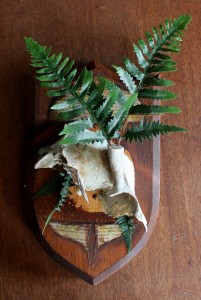
So other than a few headdresses for my vending booth and whatever custom orders came in, I stopped making them a regular part of my art. I kept experimenting with new media, and pushed myself out of my comfort zone. I began feeling that I didn’t just want to not be known only as “Lupa the headdress artist”–I also felt corralled into the label of “Lupa the hide and bone artist”. So I spent much of the winter trying to reinvent myself and my artwork, not throwing out the good things, but adding on more good things, if that makes sense.
I really needed it, too. One of the things about being an artist for a living, rather than as a hobby, or having someone else financially supporting you while you make art, is that there are certain popular pieces that will replace your day job as your primary form of income. It’s easy to get stuck in a rut with them, too, and I realized that art had stopped being as much fun because of it. I needed to be able to get back to my roots as a creative person, that busy, somewhat crazed immersion in possibilities melded with opportunities serving as brief snapshots of where I was with regards to skill and inspiration.
And I think I felt I needed to prove something to myself and to others–that I wasn’t just a one-trick artist, that I didn’t just make headdresses (and a few other things). Moreover, at some point making headdresses became trendy, and more and more people started trying to cash in. I didn’t want to get lost in the masses, but I didn’t want to define myself by just making yet another variation on the headdress.
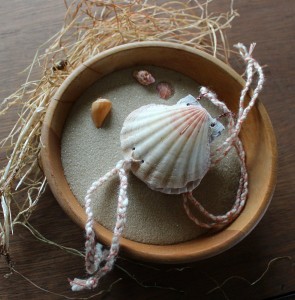
It wasn’t until this month, though, that I felt ready to go back to the headdresses. I missed them, really, and while I really enjoy making custom pieces for other people, it’s not the same as getting to create them on my own time, with no restrictions. So I pulled out a few hides I had stored away and spent a couple of weeks stitching up tears and holes, reshaping ears and faces, adding straps, and getting them ready to wear.
And then I went out with my friend Julie to Laurelhurst Park where she graciously modeled the new headdresses for me while I took photos. As I did, I felt my old enthusiasm for the headdresses coming back. Watching another person take on these spirits, even for a few minutes, and enjoy connecting with them reminded me why I started making them in the first place. I wanted to see them go to new homes where they could have that kind of attention more often, and teach someone new how to dance and shift and return to their animal selves. I wanted them to have the same opportunities my own headdresses had, and make those new relationships happen.
It led to a sense of completion, like the last piece fell into place–for the moment, anyway. No doubt I’ll want to shake things up again before too long. But for the moment, I think it’s going to be a good summer for headdresses.
You can see some of my headdresses, present and past, in my portfolio and my Etsy shop. I am also available for custom work; feel free to contact me with your ideas and requests.
Hello, Old Paint
Today is an art day. I’m bouncing between a few custom orders and what I call “cleaning through art”. That latter is where I realize the back bedroom where I keep my art supplies is a complete mess, and instead of cleaning everything up like a normal person, I pick up the nearest project idea that’s cluttering up the floor and work on it til it’s done. Sure, it only makes the room a little less messy, but at the end I have a completed project and slightly more space!
One of the projects I’m working on is a dance costume made from a tanned horse’s mane and tail that I got from a Washington taxidermist who collects deceased animals from local farms (among other sources). The tail’s going to be on a belt, as I normally do with my horse tails, and I’m adding a pair of decorated belt pouches; the leather’s all from a deerskin coat I got at the Goodwill Bins a while back. You can see one of the pouches as a work-in-progress in the picture above.
My last Bins trip also netted me the paints next to it. Shopping there is less like a regular excursion where you have a list of things you want, and more like a giant yard sale that happens every day and there’s more brought out every fifteen minutes and you really don’t know what you’re going to go home with. In recent trips I’ve hauled out a pillowcase full of pine cones, a vintage Black and White scotch bottle (empty, of course), an empty antique projector case, and a bag full of several dozen partially full tubes of acrylic paints. I wasn’t able to open up the tubes prior to purchase, so I knew it was a gamble, but it paid off–only one was all dried up, and the rest were primarily in the earthy colors I use a lot. Although acrylics are a better paint green-wise than oils, with fewer toxins and a water base, they’re still a guilty convenience purchase (I mean really, I could just be mixing my own paints from egg and pigments, right?) So I was more than happy to keep these out of the waste stream and keep myself from having to buy new paints for a while, too.
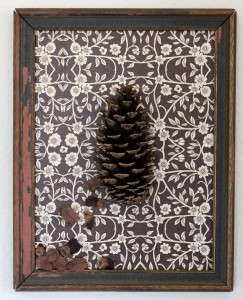 However, just because they weren’t dried up didn’t mean all the paints were in prime condition. Most of them just needed to be stirred to get the pigment to mix back in with the solvent, but some responded better than others. I hate to waste anything, and so I’ve turned working with imperfect paints into an art all its own. If some of the pigment has solidified and the paint that’s left is thin, it makes a good wash or faux-watercolor. Too thick, but still brushable? Look, it’s a texturing medium! They need to be treated a little differently than when they were new, but they’re far from useless. Even the dried out clumps of pigment can be carved into interesting shapes for assemblage work, or made into flakes to glue in as colored details.
However, just because they weren’t dried up didn’t mean all the paints were in prime condition. Most of them just needed to be stirred to get the pigment to mix back in with the solvent, but some responded better than others. I hate to waste anything, and so I’ve turned working with imperfect paints into an art all its own. If some of the pigment has solidified and the paint that’s left is thin, it makes a good wash or faux-watercolor. Too thick, but still brushable? Look, it’s a texturing medium! They need to be treated a little differently than when they were new, but they’re far from useless. Even the dried out clumps of pigment can be carved into interesting shapes for assemblage work, or made into flakes to glue in as colored details.
Some artists are really particular about their media; they can’t get the exact effect they want if the chemistry’s a little off, or the texture is wrong. I, on the other hand, love all the wrongness. There’s a certain joy I get as an artist out of using things that were discarded by others, whether it’s old hide scraps or bits of plastic or damaged household items. I love the challenge of making the imperfect beautiful, of watching it transform from refused into rejuvenated.
And I think, as a society, we might do better to fall in love with imperfection a little more. I know people who won’t shop at a thrift store because “That’s where the poor people go”. The classism of that statement is a whole other rant in and of itself, but I will point out now that this attitude ties right in with what I was talking about a few weeks back about saving only the best for ourselves. We waste so many resources, artistic and otherwise, because we turn out noses up at the imperfections, the challenges in making something work.
But that’s why I’m a Hyena Artist following the Way of the Scavenger. Their loss is my gain, and few things thrill me more than digging into the Bins and seeing what goodies I come up with to make stuff out of. And now I’m going to go back to painting with my old paints, on the secondhand leather pouch, because it’s going to be awesome when it’s done.
*By the way, the assemblage piece a few paragraphs up is made with one of those aforementioned pine cones, along with other reclaimed materials. You can find out more about it here.
The Tragic Treatise of the Teacup Tauntaun: Part 2
Note: This is a piece of fan fiction I wrote for a booklet accompanying my Star Wars-themed altered taxidermy piece, the Teacup Tauntaun. You can see more pictures of this piece and find out more about its construction here. Part one of this written piece
Also, a quick shout-out to Cory Doctorow BoingBoing for sharing this critter in a post–many thanks!
A Victim of Its Own Success
Vordon was never particularly good at promotion, and although he sent a few dispatches out regarding the availability of new litters of Teacup Tauntaun, few visitors came to see his stock, and no one made a purchase. It is said by those who survived the experience that the normally noxious scent of the Tauntaun was concentrated even more greatly in this smaller version, which led to suspicions that Vordon had a particularly poor sense of smell, even for a Hutt.
Irrationally and desperately hoping that supply would create demand, Vordon continued breeding Teacup Tauntauns irresponsibly and only with an eye toward what he thought would be fashionable, with frequent inbreeding and little care for the animals’ health. He purchased more caves in which to keep his animals, and redoubled his meager promotional efforts, all to no avail.
By 68 ABY, even Vordon had to admit that things were not looking good for his scheme. The very traits that he had selected had become so exaggerated as to become harmful—sometimes even lethal—to newer litters of Teacup Tauntauns. The large pair of horns, meant now to be more ornamental than practical, had grown so long that they often extended far beyond the muzzle of mature animals, making it impossible for them to eat without assistance. Even the smaller horn buds had become hazardous; as the average size of a Teacup Tauntaun’s skull shrunk with each generation, the horn buds became more crowded, until one pair was routinely located so as to interfere with the animal’s ability to move its ears properly.
Sometimes this skull shrinkage would outpace the downsizing of the brains of Teacup Tauntauns. After several generations, some unfortunate animals would be born with skulls too small for their brains, leading to sometimes severe and painful neurological problems that eventually proved fatal. Others had such badly malformed hip joints that they were unable to walk properly. The list of health problems goes on and on: spinal deformities, missing teeth, and a disease that progressively robbed the animal of the ability to absorb nutrition from its food, leading it to slowly starve to death—or die from a burst stomach from overeating in desperation. The normally social Tauntauns at times would resort to killing their own suffering offspring to end their pain, displaying more compassion and intelligence than their breeder apparently showed.
Worse, a famine struck the region of Hoth where Vordon’s operations were located after the lichens that composed an important link of the ecosystem were stricken by a periodic bout of lichen blight. Wild stocks of Common and Glacial Tauntauns died of starvation, and the Teacup Tauntauns in their relatively flimsy pens became repeated targets for hungry Wampas. In the space of a year, the number of Teacup Tauntauns dropped to less than a dozen.
And Then There Was One
In 90 ABY, less than seventy standard years after Vordon began his ambitious project, the last Teacup Tauntaun passed away from a combination of congenital defects. Due to her stench, which was caused by the waste system of a Common Tauntaun being concentrated into the smaller body of a Teacup Tauntaun, and which as a result was repulsive enough to cause even the last two male Teacup Tauntauns to avoid her, she never reproduced. With her death, her species came to an ignominious end. Shortly before the animal—nicknamed “Yipo the Fluffy”—passed away, your beloved author was able to examine her and make a deal with Vordon to purchase her carcass once she had died of natural causes. It was the only Teacup Tauntaun Vordon ever sold.
Her head is mounted on a board decorated with idyllic scenery that belies the harshness of Hoth, her ancestors’ home planet, and reflects the romanticized imagery Vordon used in his sales pitches. She has been preserved with traditional Krish taxidermy techniques to best approximate her appearance in life, and with care this rare piece of history should last for a long, long time. Further, she should be seen as a reminder of our responsibility to our fellow creatures. When most species go extinct it is a tragedy; in the case of the Teacup Tauntaun, extinction was the final mercy.
About the Author
Haali Dendrac grew up in the floating city of Avtuu on her ancestral planet Ithor. From a young age, she knew she wanted to join the Ithorian nature priesthood, and voraciously questioned anyone she could about the flora, fauna and fungi that resided “in the arms of Mother Jungle”. When she came of age, she was made an acolyte of the priesthood and was allowed to accompany them on her first journey to the surface of Ithor, and nothing was ever the same. After the destruction of Ithor, she became one of the strongest proponents for the restoration of the planet’s ecology and continues to act as a consultant in the early efforts toward that end. Her youthful curiosity about the diversity of life on her home planet led her to further explore life on other planets, and she has dedicated her life to documenting her findings for the enjoyment of all. The Tragic Treatise of the Teacup Tauntaun is her fourth publication.
Artist’s Note
This piece is meant as a parody concerning the overbreeding of certain breeds of show dog in our world. While I am not against purebred dogs as a general concept, I find that many breeders, especially of popular breeds, put profits before puppies. There are few pure breeds today that do not have a slew of congenital defects. I have chosen to draw on a few of them in my discussion of the fictional Teacup Tauntaun. For example, it is estimated that over half of all Cavalier King Charles Spaniels have a condition known as syringomyelia, in which the skull is too small for the brain, which is pressed out the back of the skull cavity and causes both seizures and immense amounts of pain. And my own favorite breed, the German Shepherd, is frequently plagued by hip and elbow dysplasia, along with spinal myelopathy, a degeneration of the myelin sheath on the spinal cord which leads to a progressive numbing and eventual failure of the back half of the dog.
It is my hope that this piece will help raise awareness of the problems with inbreeding and indiscriminate breeding without care for these inherited health problems in pure breed dogs. Additionally, a portion of the funds from the sale of this piece will be donated to Multnomah County Animal Services to help them take better care of the animals waiting for forever homes there. MCAS is often overlooked in lieu of “sexier” shelters like the Oregon Humane Society, but when the time comes when I can finally get a dog of my own again, MCAS will be my first choice. I hope you’ll consider them the next time you wish you adopt a dog or cat, too.
Also, if you’d like to see the Teacup Tauntaun itself in person, it will be on display at Good: A Gallery here in Portland, OR for the month of May. The group show officially opens this Friday, May 2, from 7pm – 10pm; here’s more information.

